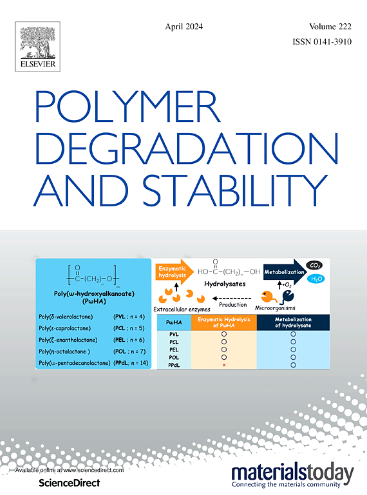Deeper insights into flame retardancy of polymers by interpretable, quantifiable, yet accurate machine-learning model
IF 6.3
2区 化学
Q1 POLYMER SCIENCE
引用次数: 0
Abstract
Fire-safety polymer materials are essential in modern society such as electronics, aerospace, new energy. The quantification and prediction of flame retardancy, determined by the chemical composition and the burning process, has always been a bottleneck challenge. Previous empirical design rules and the existing models show large deviations for predicting flame retardancy and are often unexplainable. Here, this study proposes an interpretable model that can quantify the groups contribution of flame-retardancy and predict the flame retardance of intrinsically flame-retardant polymers. The machine learning model simultaneously considers the group structures and their flame-retardant mechanism in both the gas phase and condensed phase, achieving high prediction accuracy (89.8% for the training set and 83.8% for the testing set). It also quantifies the contribution values of various flame-retardant groups (halogen-containing structures, phosphorus-containing structures, phosphorus-nitrogen-containing structures, aromatic ring-containing structures, etc.) in both phases for the first time. The running script that integrates the model has also been open-sourced, providing an emerging strategy for transitioning flame-retardant research from empirical methods to scientific design.
通过可解释、可量化且准确的机器学习模型,深入了解聚合物的阻燃性能
阻燃高分子材料在电子、航空航天、新能源等现代社会中不可或缺。阻燃性由化学成分和燃烧过程决定,其量化和预测一直是一个瓶颈难题。以往的经验设计规则和现有模型在预测阻燃性方面存在较大偏差,而且往往无法解释。在此,本研究提出了一种可解释的模型,该模型可量化阻燃性的基团贡献,并预测本征阻燃聚合物的阻燃性。该机器学习模型同时考虑了气相和凝聚相中的基团结构及其阻燃机理,实现了较高的预测准确率(训练集为 89.8%,测试集为 83.8%)。它还首次量化了气相和凝结相中各种阻燃基团(含卤结构、含磷结构、含磷氮结构、含芳香环结构等)的贡献值。集成该模型的运行脚本也已开源,为阻燃剂研究从经验方法过渡到科学设计提供了一种新兴战略。
本文章由计算机程序翻译,如有差异,请以英文原文为准。
求助全文
约1分钟内获得全文
求助全文
来源期刊

Polymer Degradation and Stability
化学-高分子科学
CiteScore
10.10
自引率
10.20%
发文量
325
审稿时长
23 days
期刊介绍:
Polymer Degradation and Stability deals with the degradation reactions and their control which are a major preoccupation of practitioners of the many and diverse aspects of modern polymer technology.
Deteriorative reactions occur during processing, when polymers are subjected to heat, oxygen and mechanical stress, and during the useful life of the materials when oxygen and sunlight are the most important degradative agencies. In more specialised applications, degradation may be induced by high energy radiation, ozone, atmospheric pollutants, mechanical stress, biological action, hydrolysis and many other influences. The mechanisms of these reactions and stabilisation processes must be understood if the technology and application of polymers are to continue to advance. The reporting of investigations of this kind is therefore a major function of this journal.
However there are also new developments in polymer technology in which degradation processes find positive applications. For example, photodegradable plastics are now available, the recycling of polymeric products will become increasingly important, degradation and combustion studies are involved in the definition of the fire hazards which are associated with polymeric materials and the microelectronics industry is vitally dependent upon polymer degradation in the manufacture of its circuitry. Polymer properties may also be improved by processes like curing and grafting, the chemistry of which can be closely related to that which causes physical deterioration in other circumstances.
 求助内容:
求助内容: 应助结果提醒方式:
应助结果提醒方式:


